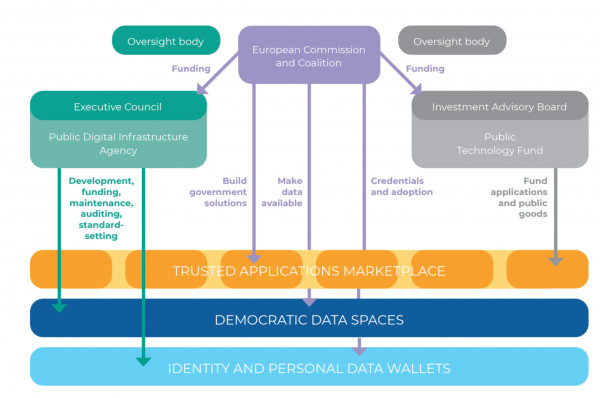Report by Katja Bego: “…We already have the technical and governance building blocks at our disposal to make this Public Digital InfrastructureI model a reality. We also have the political momentum on our side through a number of ambitious policy proposals and funding agendas on the European level. The challenge now is to integrate these building blocks into a single cohesive system, and to ensure we put into place the right institutions and rules to ensure the DPI can achieve trust, scale and openness. This approach is made up of three key pillars:
- Generating an ecosystem of healthy, interoperable alternatives:
Public Digital Infrastructure could help us move away from a platform economy, where one actor owns a whole suite of tools and can unilaterally set the rules, towards a protocol-based economy, in which we could see a collaborative ecosystem of smaller, interoperable solutions and applications emerge, built on top of a shared set of rules and open protocols. We could see this as an alternative, parallel infrastructure, made up of open, trustworthy solutions and public goods. Through collaborative interoperability, solutions built on top of the Public Digital Infrastructure would proactively set out to integrate their solutions with other tools built on the framework.
To help this ecosystem thrive, the Commission and other governing bodies (from the local level to the supra-national) would seek to leverage their own market shaping-levers, for example through strengthening rule-setting through procurement, and moving their own solutions on top of the system. The European Commission would further provide the funds for an independent Public Technology Fund, which would support the development of applications on top of the Public Digital Infrastructure, as well as fund public goods to support the wider ecosystem. - Designing governance models fit for purpose: No single centralised entity – public or private – would control the underlying Public Digital Infrastructure model; instead, the system would be governed on the basis of a shared set of rules and protocols for, for example, interoperability, data sharing and online identity management. In this model, civil society, trusted public institutions, academia, and the public-interest technology community would be empowered to collaboratively shape the rules, standards and governance models underpinning this shared logic.
To ensure these decision-making processes remain open and representative, but also geared towards effective decision-making, the European Commission would provide the funding for the establishment of a fully independent Public Digital Infrastructure Agency, tasked with bringing together the community, and providing resources for maintenance and auditing of the PDI’s components.
- Opening up data and identity: Every internet user would be provided with the means to control their own digital identity and personal data online, empowering them to share what they want, with whomever they want, on their own terms. To do this, each user of the Public Digital Infrastructure model would have the right to be issued their own portable online identity and personal data wallet, which would allow them to share and pool data on a case by case, consent-based basis.
Developers of applications and services would be able to tap into the user-generated data commons that would result from this pooling in a way that is accountable and fair, rather than feel compelled to amass their own proprietary data lakes in order to compete. We should not imagine these commons as one single enormous, distributed data lake, but rather as a set of data governance mechanisms, ranging from data commons to trusts, which would be employed and governed depending on the use case and sensitivity and utility of the data at hand. Users would be able to pick and choose which commons to participate in, and solutions would contribute to these commons as a condition of being part of the PDI….(More)”
